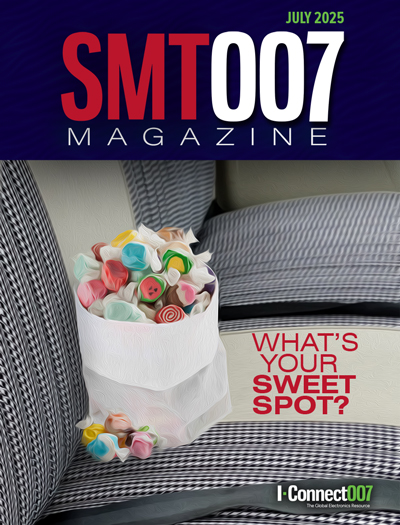-

- News
- Books
Featured Books
- smt007 Magazine
Latest Issues
Current Issue
Supply Chain Strategies
A successful brand is built on strong customer relationships—anchored by a well-orchestrated supply chain at its core. This month, we look at how managing your supply chain directly influences customer perception.

What's Your Sweet Spot?
Are you in a niche that’s growing or shrinking? Is it time to reassess and refocus? We spotlight companies thriving by redefining or reinforcing their niche. What are their insights?

Moving Forward With Confidence
In this issue, we focus on sales and quoting, workforce training, new IPC leadership in the U.S. and Canada, the effects of tariffs, CFX standards, and much more—all designed to provide perspective as you move through the cloud bank of today's shifting economic market.
- Articles
- Columns
- Links
- Media kit
||| MENU - smt007 Magazine
Material Effects of Laser Energy When Processing Circuit Board Substrates During Depaneling
July 27, 2016 | Ahne Oosterhof, LPKF Laser & Electronics North AmericaEstimated reading time: 13 minutes
Figure 8: Surface resistance measurement.
If so desired, a simple cleaning process can be added and will remove the remaining particles. This can be done by wiping with a smooth dry or wet tissue, using compressed air or brushes.
Thermal Effects
Even though UV laser can be called “cold” lasers, there still is some heat being generated. Its impact is very dependent on the settings of the laser system. The laser beam inserts some heat into the material being cut and heat is being removed by dispersion into the material, radiation into the environment and convection into the air using forced air flow over the material.
Figure 9: Simulation of heat accumulation.
The heat equation is a parabolic partial differential equation that describes the distribution of temperature in a given region over time.
The resulting graph (Figure 9) shows the gradual increase in temperature for multiple passes with the laser beam along a cutting path. Ultimately a balance will be reached between applying heat and dispersing, radiating and convection of heat away from the cut area.
In order to determine what actually occurs in the circuit board material near the kerf cut by the laser, linear temperature sensors were placed on a test board (Figure 10).
Figure 10: Linear temperature sensors (circled) on the test board.
In this test, the tabs were cut, some of which are bare FR4, some are FR4 with copper and some are FR4 without the routed slots and the nearby temperature rise was measured.
The tabs where the sensors were placed were cut with the cutting path at different distances from the sensor. Even when cutting within 0.1 mm from the sensor, the temperature reached only 100°C, well below any temperature the board is normally being exposed to during the soldering process.
Figure 11: Cutting in one material type, measuring at different distances.
The cutting parameters for this example were: P = 12.4W, v=244 mrn/s, rep = 30, CT = l00 ms, full-cut FR4 (thickness 400-450 μm).
Cooling time (CT) is the time it takes for the beam to return to the same location. During this time other sections of the outline are being cut and it can also include a rest period between repetitions. The cooling time in this example was 100 ms.
To compare examples of cutting through the different materials, bare FR4, FR4 with copper and a full-cut FR4 were investigated, with the results showing in Figure 12.
Page 3 of 6
Testimonial
"The I-Connect007 team is outstanding—kind, responsive, and a true marketing partner. Their design team created fresh, eye-catching ads, and their editorial support polished our content to let our brand shine. Thank you all! "
Sweeney Ng - CEE PCBSuggested Items
LPKF Increases Revenue in the 1H of 2025 Despite global uncertainties
07/24/2025 | LPKFThe LPKF Group increased revenue by 7.2% to EUR 59.2 million in the first half of 2025 and achieved an almost balanced adjusted EBIT* (earnings before interest and taxes) of EUR -0.7 million.
Altus, Danutek Expand Partnership with LPKF to Offer Laser Plastic Welding Solutions
05/21/2025 | Altus GroupAltus Group, a leading supplier of capital equipment and service support for the electronics manufacturing sector in the UK and Ireland, and its sister company Danutek, which serves Central and Eastern Europe, are expanding their technology offering through an enhanced partnership with LPKF, a specialist in laser-based manufacturing solutions.
LPKF Reports Results for Full Year 2024
03/27/2025 | LPKFThe technology company LPKF Laser & Electronics SE published today its annual report for 2024. Despite the challenging economic conditions for the German mechanical engineering industry, LPKF was able to maintain its revenue slightly below the previous year's level at EUR 122.9 million.
Queen's University Belfast Enhances RF Research with LPKF ProtoLaser R4
03/26/2025 | LPKFThe Centre for Wireless Innovation (CWI) at Queen's University Belfast relies on the state-of-the-art LPKF ProtoLaser R4 to conduct RF research with high-precision structuring of sensitive materials.
Real Time with... IPC APEX EXPO 2025: LPKF's Advancements in Laser Depaneling Technology
03/25/2025 | Real Time with...IPC APEX EXPOIn this recent interview, Jake Benz from LPKF Laser and Electronics discusses advancements in laser depaneling technology, focusing on speed and quality. He highlights the previous negative reputation of laser depaneling and shares insights from nearly two decades of experience. As customer needs evolve, traditional companies are exploring laser technology.


